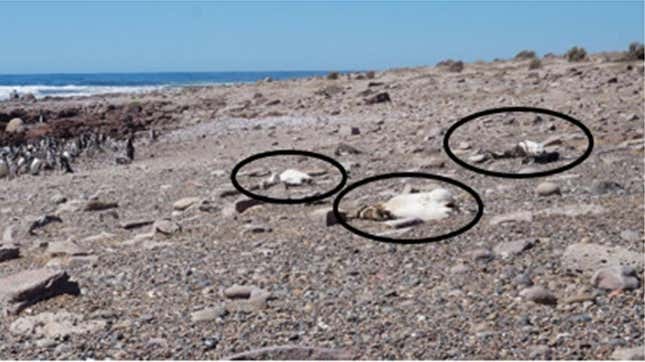
New research details the devastating impact of an extreme weather event on a colony of Magellanic penguins living along Argentina’s east coast.
Upwards of 354 Magellanic penguins died on Jan. 19, 2019, according to research published in Ornithological Applications. The tragic event happened at Punta Tomba in eastern Argentina, home to one of the largest Magellanic penguin breeding colonies in the world. The biologists behind the new paper, Katie Holt and P. Dee Boersma from the University of Washington, say that, for this species, it was an “unprecedented, single-day, heat-related mortality event.”
On that day in Punta Tomba, the temperature in the shade reached 111 degrees Fahrenheit (44 degrees Celsius), marking the highest temperature for the region since recordkeeping began 40 years ago. The previous single-day record was 109 degrees Fahrenheit (43 degrees Celsius), but no penguin die-offs were recorded for that particular event.
“This extreme event fell near the tail end of the breeding season for Magellanic penguins, so it killed a large number of adults, as well as chicks,” Holt, a doctoral student in biology, explained in a University of Washington press release. “It’s the first time we’ve recorded a mass mortality event at Punta Tombo connected to extreme temperatures.”

Sifting through the beaches in the days following the heat blast, Holt and Boersma recorded 264 dead adults and 90 dead chicks. Many birds were found on their stomachs with all four limbs extended and bills open—a posture commonly used by penguins to expel excess heat. A particularly hard-hit section of the colony saw as many as 5% of 1,153 adults succumbing to the heat. The uneven distribution of mortality is likely the result of microclimates and/or uneven access to the beach, according to the paper.
Post-mortems of the penguins pointed to dehydration as the primary cause of death. The researchers didn’t detect other potential causes, such as disease, starvation, or toxic algae. Disturbingly, around one-quarter of all dead penguins died while moving from their nesting area to the ocean, as the birds were likely making a desperate dash to reach the ocean and gulp some precious liquid (penguins have a special gland that allows them to filter salt from ocean water). For some penguins, however, that meant a journey of a full 0.6 miles (1 kilometer) or more and a trek lasting for 40 minutes.

“Any mass die-off like this is a concern,” said Holt. “But what is most concerning about heat-death mortality is that it has the potential to kill a lot of adults,” who are needed to keep the population viable. “If we’re losing large numbers of adults from a single event like this, that’s a major concern,” she added.
Males perished far more frequently than females, but this reflects a skewed sex ratio; typical Magellanic colonies host three males to every female. Unlike many of the dead adults, the chicks died with their stomachs full of food. While well hydrated, their tiny bodies could not regulate their temperature in the extreme heat, according to the study.
By documenting the effects of this and other extreme weather events, researchers will be better equipped to predict how wildlife will respond to climate change. And though rare, these events “are expected to become more frequent and could have severe impacts on populations,” the scientists write in their paper. Indeed, intense heat is one of the most telltale signs of climate change, one that’s become alarmingly more common in recent years.
Extreme heat events aren’t just bad for wildlife—they’re also bad for humans. The heat dome that struck western North America in June 2021 is a recent potent example. Hundreds of people died during this unprecedented heat spell, setting temperature records in Canada and the Pacific Northwest. A subsequent analysis found that the heat wave was 150 times more likely in our current climate compared to the pre-industrial one. Research from 2020 showed that extreme heat might eventually cause as many deaths as all infectious diseases combined, but, even now, approximately one-third of all heat-related deaths are attributable to human-caused climate change.
More: Bee swarm kills 63 endangered penguins in “fluke” occurrence